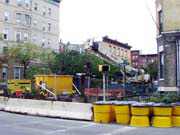Within the last six months, three highly visible projects, which include large-scale digging and construction, have been started by the North Hudson Sewerage Authority to control the amount of solid floating objects that are discharged into the Hudson River.
The first is north of the ferry terminal near the termination of Newark Street, the second is just north of the 333 River St. residential building at Fourth Street, and the third is near the corner of 11th and Hudson Streets. The later project has caused the westbound lane of 11th Street to be closed for nearly six months.
In total, the NHSA has eight “combined sewer overflow” abatement projects in Hoboken, Weehawken, and West New York at a total cost of approximately $26 million or just over $3 million per project, said Fred Pocci, the executive director of the North Hudson Sewerage Authority.
“We know that it’s an inconvenience, but it is something we are required to do by law,” said Pocci. He added that because the projects are being undertaken in tight spaces in heavily trafficked areas, they are extremely challenging and expensive projects to undertake. “We are working with the mayor and the city to make sure we finish these projects as quickly as possible,” he said.
What is combined sewer overflow?
According to information provided by the federal Environmental Protection Agency (EPA), combined sewer overflows (CSO) are remnants of the Hoboken’s early infrastructure. Many years ago, cities such as Hoboken built combined sewer systems for collecting both wastewater and storm water. These combined sewers are still in operation today.
During dry weather, the combined sewers do not pose a problem and can effectively channel domestic and industrial waste to the treatment plants. But during heavy rains, the sewers do not have the capacity to carry the combined rainwater and waste water; therefore, the combined flow is discharged into the river.
According to the Environmental Protection Agency, 1,200 billion gallons of combined raw sewage and storm water are discharged into U.S. streams, lakes, rivers and estuaries each year.
The EPA, through the National Pollutant Discharge Elimination System, provides policy guidance to local, state, and federal authorities on how to meet the goals of the federal Clean Water Act.
In both New York and New Jersey, these are several large CSO abatement projects underway. The three projects in Hoboken are called “solid floatable chambers” and are designed to reduce or eliminate the visible solid waste that is often present in CSO discharges.
The abatement facilities use the passive energy of the effluent stream to drive the floatable materials that are a half-inch and or larger into disposable mesh nets. As Pocci points out, the system does not keep pollutants from getting into the river, but does filter out solid material which protects the aesthetics of the waterfront and beaches in the metro area.
According to Pocci, all three of the Hoboken projects should be complete in about four months. He added that he NHSA will be sending out a mass mailing in the next couple weeks to keep residents up to date on the progress of the projects.
